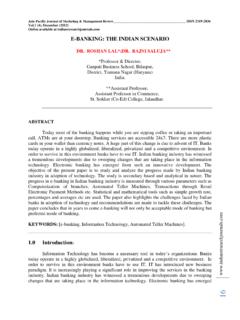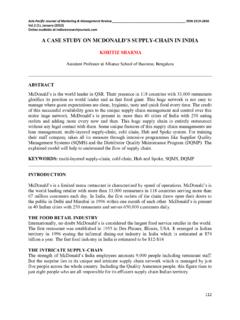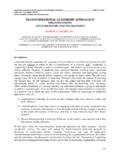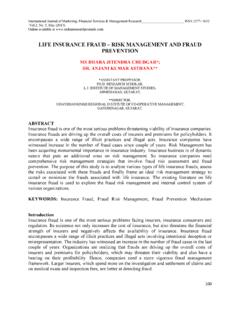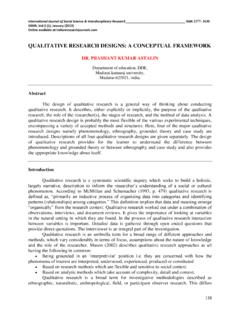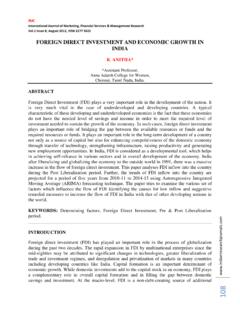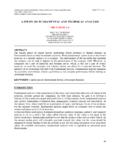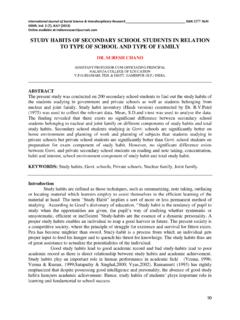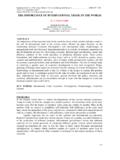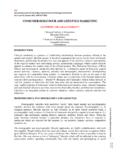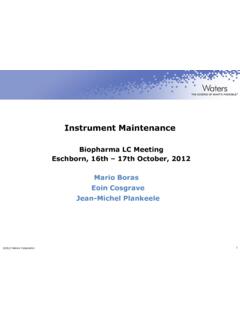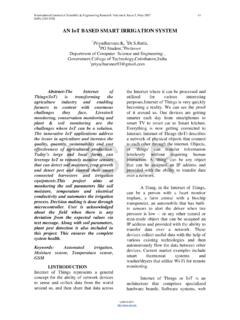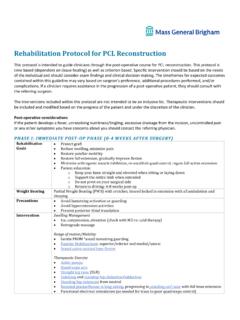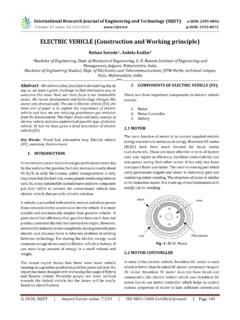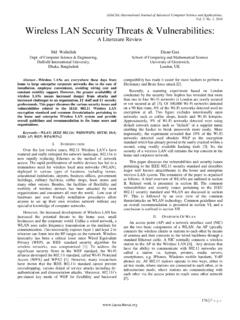Transcription of GENDER ISSUES: THE ROLE OF WOMEN IN AGRICULTURE …
1 International journal of Marketing, Financial Services & Management Research_____ ISSN 2277- 3622 , No. 9, September (2013) Online available at 134 GENDER ISSUES: THE ROLE OF WOMEN IN AGRICULTURE SECTOR IN INDIA BIBHU SANTOSH BEHERA*; ANAMA CHARAN BEHERA* *POST GRADUATE RESEARCH SCHOLAR, COLLEGE OF AGRICULTURE ,DEPT. OF EXTENSION EDUCATION(OUAT),BHUBANESWAR,ODISHA,INDIA ABSTRACT India is developing country. The main occupation is AGRICULTURE , because 70 per cent of the population is involved in this occupation. Many WOMEN in developing countries are occupied in AGRICULTURE . WOMEN occupation in AGRICULTURE in low income countries in Asia is between 60-80 per cent. In almost, Asian countries, the number of WOMEN employed in AGRICULTURE as a percentage of the economically active population is higher.
2 Long standing obstacles faced by rural WOMEN in terms of limited access to productive resources (Land, Credit, Inputs, Transport, Extension Services, Storage and Technical Assistance) prevent them from adopting new technologies or encoring them economies of scale. This paper examines the ways in which greater integration through AGRICULTURE impact WOMEN and men differently and ensures implications for growth. This paper finds that AGRICULTURE creates many jobs for WOMEN in AGRICULTURE sector. Jobs that bring many household resources under WOMEN control leads to greater earnings in the family. Although, WOMEN are more than ever finally employed, differences in wages earned by WOMEN and men persist in all countries. WOMEN also have less access to productive resources specially in developing countries.
3 Due to these reasons and WOMEN s lower education level compel the WOMEN have a greater tendency to remain in subsistence AGRICULTURE . Professional WOMEN continue to discrimination in hiring and promotion. The impact of liberalization and globalization on WOMEN is important not only because they represent almost half of the total population, but also because they face constraints, which make them less beneficial from the liberalization. Once different impacts are ascertained well designed policy responses may aid WOMEN in taking advantage of greater openness to the womens are more working than men & most of the Farming activities(80%) is done by Females so this era is called as Feminization of AGRICULTURE & Female face of implies the WOMEN based empowerment by Yatra Naryestu Tatra Devtah .It means if we give equality,equity & respect to the WOMEN then every growth is possible whis is relevant to Presence of God means happiness with growth & Development.
4 KEY WORDS: AGRICULTURE , GENDER , Liberalization, Impacts, Globalization and Discrimination Introduction: Swaminathan, the famous agricultural scientist describes that it was woman who first domesticated crop plants and thereby initiated the art and science of farming. While men went out hunting in search of food, WOMEN started gathering seeds from the native flora and began International journal of Marketing, Financial Services & Management Research_____ ISSN 2277- 3622 , No. 9, September (2013) Online available at 135 cultivating those of interest from the point of view of food, feed, fodder, fibre and fuel. WOMEN have played and continue to play a key role in the conservation of basic life support systems such as land, water, flora and fauna. They have protected the health of the soil through organic recycling and promoted crop security through the maintenance of varietal diversity and genetic resistance.
5 That WOMEN play a significant and crucial role in agricultural development and allied fields including in the main crop production, livestock production, horticulture, post harvest operations, agro/ social forestry, fisheries, etc. The nature and extent of WOMEN s involvement in AGRICULTURE , no doubt, varies greatly from region to region. Even within a region, their involvement varies widely among different ecological sub-zones, farming systems, castes, classes and stages in the family cycle. But regardless of these variations, there is hardly any activity in agricultural production, except ploughing in which WOMEN are not actively involved. Studies on WOMEN in AGRICULTURE conducted in India and other developing and under developed countries all point to the conclusion that WOMEN contribute far more to agricultural production than has generally been acknowledged.
6 Recognition of their crucial role in AGRICULTURE should not obscure the fact that farm WOMEN continue to be concerned with their primary functions as wives, mothers and homemakers. Despite their importance to agricultural production, WOMEN face severe handicaps. They are in fact, the largest group of landless labourers with little real security in case of break-up of the family owing to death or divorce; inheritance laws and customs discriminate against them land reform and settlement programmes usually give sole title and hence the security needed for obtaining production credits to the husband. Agricultural development programmes are usually planned by men and aimed at men. Mechanization, for example alleviates the burden of tasks that are traditionally men s responsibility, leaving WOMEN s burdens unrelieved or even increased.
7 It may not be out of place to mention here that considering their dual responsibilities within and outside the home , it would be in the fitness of things that more and more in the village training is organized for rural farm WOMEN to suit their convenience with due realization that institutional training is important in its own place. In order that farm WOMEN get a fair deal at the hands of change agents, one of the remedial measures that needs to be undertaken is to induct a sizeable number of well trained WOMEN personnel in training and extension programmes of agricultural development agencies at all levels and more so at the grass-root level. Main Objectives of the Study: The main objectives of the present study are as follows: 1. To find out the role of WOMEN in AGRICULTURE and its allied fields. 2.
8 To find out main obstacles in WOMEN growth in AGRICULTURE sector. 3. To analyze the GENDER differences in roles and activities in AGRICULTURE sector. International journal of Marketing, Financial Services & Management Research_____ ISSN 2277- 3622 , No. 9, September (2013) Online available at 136 4. To find out the various ways and means to reduce GENDER differences and to improve the role of WOMEN in the AGRICULTURE sector. 5. To analyze & frame policy for WOMEN Upliftment by maintaining GENDER Main streaming & Equity. prepare a concept road map, relevant strategies with formulation of GENDER Budget & cell for future WOMEN . Literature Review: There is a vast body of literature linked with role of rural WOMEN in AGRICULTURE and its allied fields, but here we mention only recent work being done on the topic. Brohi Sikandar (2005) in his research paper entitled NDP Irrigation Reforms Lack GENDER Equality argued that despite gargantuan efforts and uncasing participation in socio-economic field, WOMEN role has been discarded.
9 Meer & Parhiar (2005) has investigated in his research article entitled Understanding Poverty in Rural Sindh that rural WOMEN do all on farm/off farm works. Her day begins from pre-dawn with crushing. Their traditional role of housekeeping has been extended to collect firewood, fodder, and working on farms. Owing to social taboos, ignorance, financial constraints, inadequate education facilities, and non-availability of lady teachers in rural girls , schools have not opened the doors of literacy for them. AGRICULTURE - dependent rural people have struggled to improve their economic conditions. On the contrary, shortage of water, dry spell cycles, decrease in cultivable area due to soil deterioration, extension of towns and villages, contraction of infrastructure, rising cost of inputs, non- availability of high yield quality varieties seeds to small farmers, un-checked population growth, etc, have together adversely affected the lives of rural people.
10 Malik Saeeda (2005) in her paper WOMEN Welfare Projects and Development has highlights the deplorable conditions of rural WOMEN . In her research, she has tried to link economic development with WOMEN welfare. For the development of WOMEN , she emphasizes on the need for governments to initiate WOMEN welfare projects. Zar Quresh (2005) has mentioned in his paper Role of Rural WOMEN that role of WOMEN in AGRICULTURE sector is as important as men, therefore, WOMEN should educate themselves in agricultural. He also highlights the importance of education to rural female and proposed to educate WOMEN in floriculture and food preservation. Alam SM (2006) has pointed out in his article entitled Production Hazards, Marketing Risks mentioned that majority of WOMEN is self-employed and work in dangerous environments. Their daily tasks includes keeping and caring for the livestock at farms.
